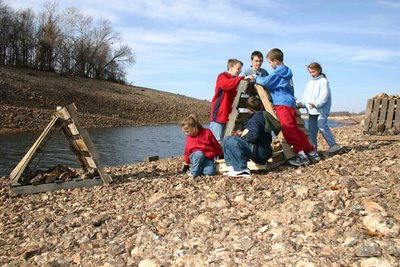Kids Connect to Save Fish at W.R. Holway

Salina — "We’re building homes for the little fish, so they won’t be eaten by the big fish," said seven-year-old Reid Patton. Kids from Green Country Council of Camp Fire USA (GCC), came to help the fish in the W.R. Holway Reservoir by helping the Grand River Dam Authority (GRDA) build more fish habitat.
"A lot of kids really don’t do much outdoors anymore, and we want them to be able to connect with what’s out here,"said Vicki Proctor, Camp Services Director, GCC. "Part of Camp Fire is for the kids to give back to the community--to do service projects. We connected with Brent [Davis of GRDA] and here we are."
"This was a great opportunity to show the kids how they can help the environment," said Brent Davis, GRDA’s Fishery Coordinator. "We provided the pallets and the buckets and the kids did the work."
"It was sweaty work," said eight-year-old Jack Allen. "The water level is down there and it’s going to flow back up here, so we’re building homes for the little fish, so the big ones don’t eat them."
After a little rest and nourishment, Davis and Jeff Day, GRDA biologist, took the children on a nature hike. They pointed out the different kinds of trees. Day showed the kids fossils and mussel shells. They spotted birds and wildlife. They compared their fish shelters with those that other people had put it.
"We [GRDA] are excited that the public has gotten involved," said Davis. "There is a lot of shoreline exposed, there’s no way we could get to all of it. We want to thank the Oklahoma Pre Mini-Boat Association, Oklahoma Department of Wildlife Conservation, Rainbow Concrete, and all the other individuals that have taken time to get involved. The bass club [Mini-Boats] is building a new boat ramp with help from Rainbow Concrete. Every day I come out here, I notice something else [trees, stumps] that’s been done by the local anglers."
"It’s really great to see the interest the public has taken in this project," said Dr. Darrell Townsend, Ph.D., GRDA Director of Ecosystems. "The fish will really benefit from all these efforts, and we should see an improvement in the fishery here."
The water level has been lowered so the canal could be inspected and repaired. The GRDA Ecosystems Department took advantage of the accessibility to these areas and has been building new fish shelters to help protect the small fry.
"We already have trophy size bass--the state record was caught here last spring," said Brent Davis, GRDA’s Fishery Coordinator, "but we don’t have as many smaller fish as we’d like." He explained, "We have a limited spawn because of the fluctuation of the water, and since there is limited habitat [in the reservoir], we lose even more of the fry. So by adding places for the fry to hide, we hope more of them will make it to maturity."
Along with the manufactured structures, fallen trees and brush piles were also placed around the reservoir. GRDA’s Brush Crew worked on the Chimney Rock road and parking area on the south side of the reservoir to allow better access to the far side of the water.
"We really appreciate the help and feedback that we’ve been getting from the local fishermen," said Davis. "They are excited about our efforts. This is just part of GRDA’s plan to make the fisheries better and more productive in our lakes."
State record holder Karl R. Council reeled in the state’s biggest smallmouth bass out of Holway Reservoir on March 29, 2005. His trophy weighed 8 lbs. 1 oz. measuring 22 1/2 inches with a girth of 17.32 in.
GRDA began lowering the reservoir (commonly known as the "Pumpback") in early October so repairs to the concrete canal and earthen dike could be made at the request of the Federal Energy Regulatory Commission. The work required the water level to be dropped approximately 35 feet. The reservoir is scheduled to return to normal water levels in late January when work is completed.
The W.R. Holway Reservoir in Chimney Rock Hollow is a pristine reservoir created in the late 1960s by GRDA as part of the Salina Pumped Storage Project. To ensure a relaxing fishing experience, boats with internal-combustion engines are not allowed on the reservoir. The pumpback is unique because it’s water level fluctuates so much. During the hot part of the day (high energy usage) the six reversible pump/turbine units are used to generate electricity which lowers the water level as much as 15 feet. At night, the six 64,000-horsepower units are used to pump the water back up the hill into the reservoir. It is also one of the deepest lakes in the state, reaching depths of 180+ feet.
...from Tana Poppino, GRDA




0 Comments:
Post a Comment
<< Home